CCL21-CCR7 promotes the lymph node metastasis of esophageal squamous cell carcinoma by up-regulating MUC1
- PMID: 26667143
- PMCID: PMC4678529
- DOI: 10.1186/s13046-015-0268-9
CCL21-CCR7 promotes the lymph node metastasis of esophageal squamous cell carcinoma by up-regulating MUC1
Abstract
Background: CCR7 and MUC1 are correlated with lymph node metastasis in ESCC, but the role of MUC1 in the CCR7-induced lymphatic metastasis and the underlying molecular mechanism is still unclear.
Methods: The expression of CCR7 and MUC1 was detected in the ESCC samples by IHC, and the clinical significance of CCR7 and MUC1 in ESCC was analyzed. The expression of CCR7 and MUC1 in ESCC cell lines was detected by qRT-PCR and western blot. The effect of CCL21 on the migration and invasion of ESCC cells was determined by transwell assay. The activity of MUC1 promoter was determined by luciferase reporter assay. The activation of Erk, Akt and Sp1 was detected by western blot and the binding of Sp1 to the MUC1 promoter was determined by ChIP.
Results: The co-expression of CCR7 and MUC1 was detected in 153 ESCC samples by IHC, and both were correlated with lymph node metastasis, regional lymphatic recurrence and poor prognosis. Correspondingly, increasing levels of MUC1 mRNA and protein were detected in the ESCC cell lines KYSE410 and Eca9706 after treatment with CCL21 in a time- and dose-dependent manner. Furthermore, silencing MUC1 could remarkably suppress the invasion and migration of ESCC cells induced by CCL21. Moreover, heterologous CCR7 promoted the invasion and migration of KYSE150 and up-regulated MUC1 expression. Increasing levels of activated ERK1/2 and Akt were detected in KYSE410 after treating the cells with CCL21, and inhibiting the activation of ERK1/2 but not Akt caused the increased transcription of MUC1. Finally, the phosphorylation of Sp1 induced by ERK1/2 and subsequent increases in the binding of Sp1 to the muc1 promoter at -99/-90 were confirmed to cause the up-regulation of MUC1 induced by CCL21-CCR7.
Conclusions: Our findings suggested that MUC1 plays an important role in CCL21-CCR7-induced lymphatic metastasis and may serve as a therapeutic target in ESCC.
Figures
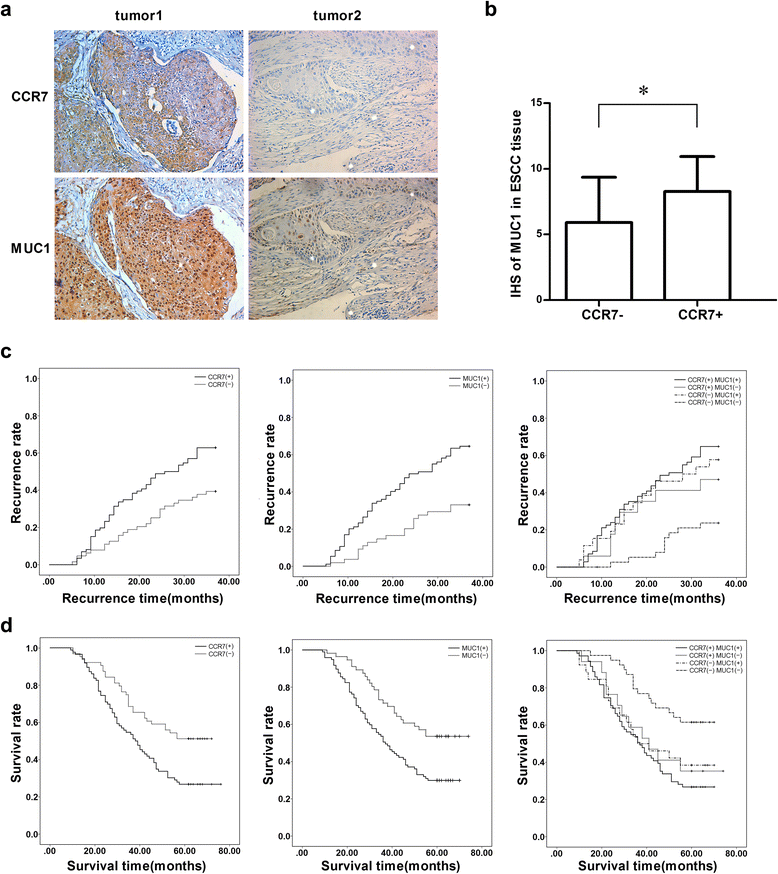
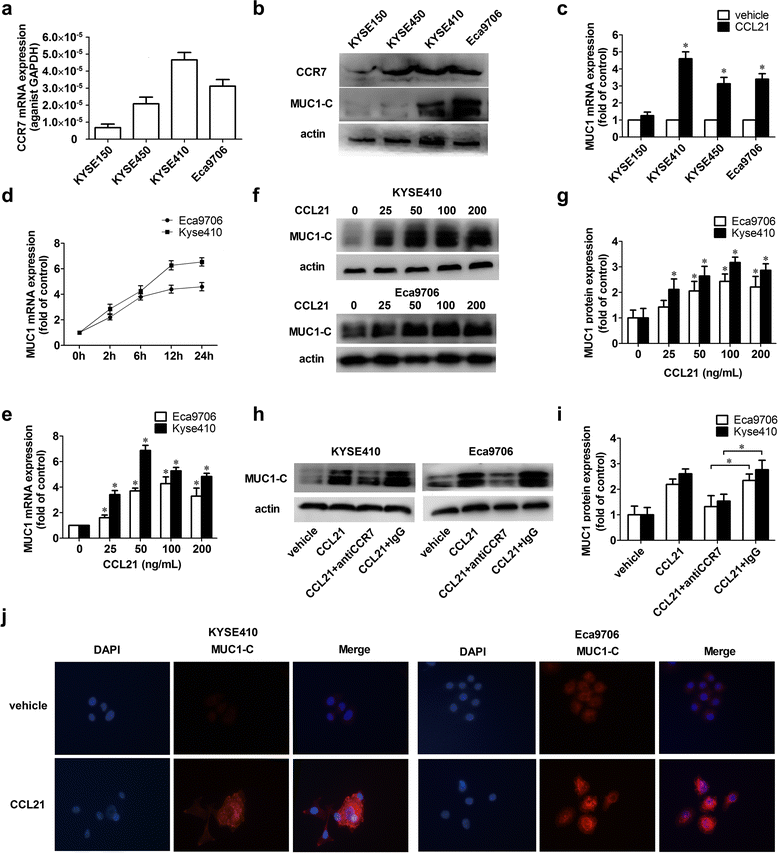
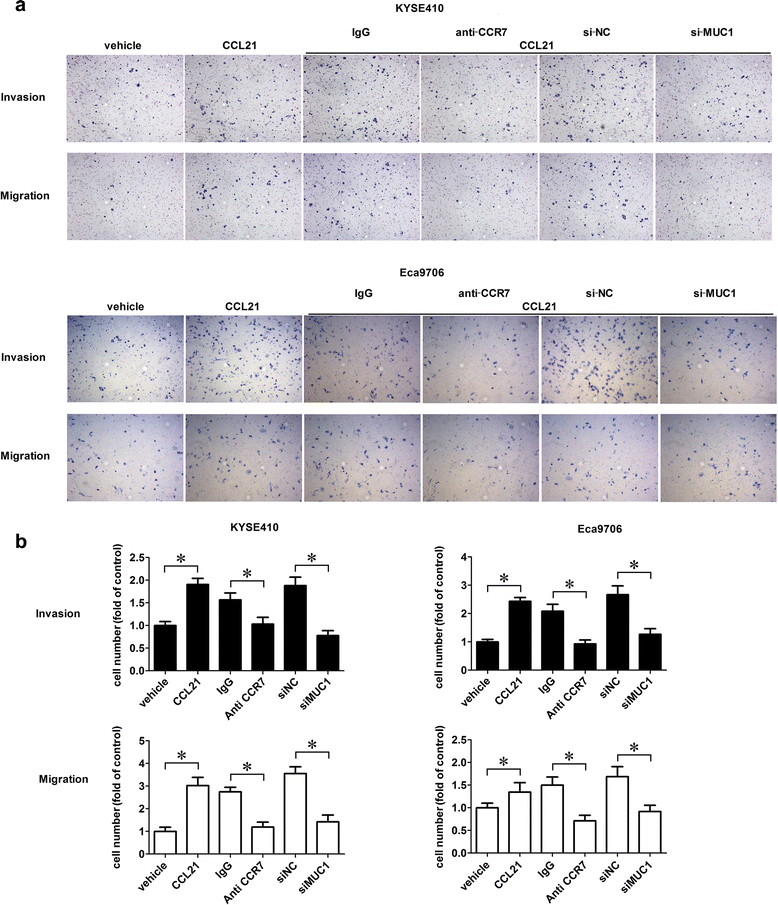
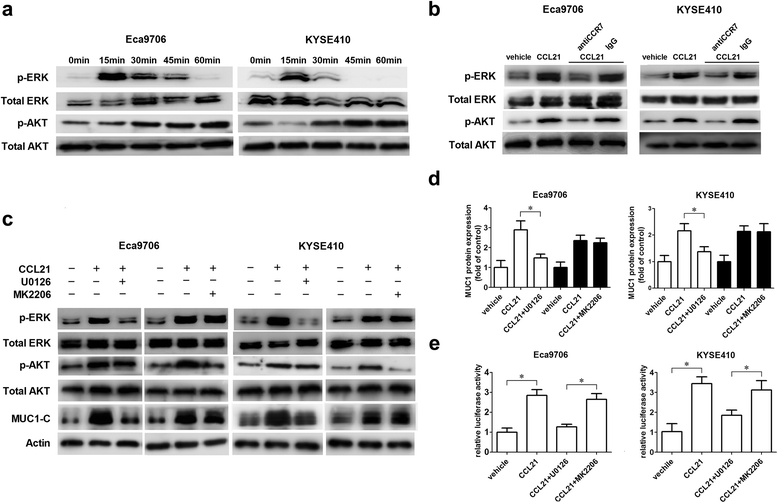
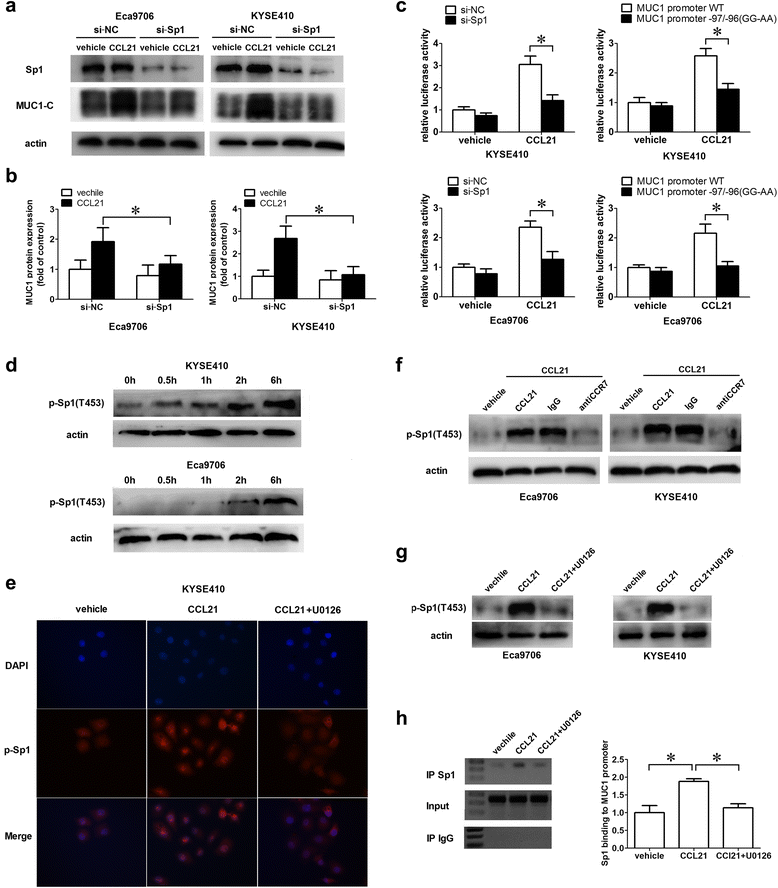

Similar articles
-
CC-Chemokine receptor CCR7: a key molecule for lymph node metastasis in esophageal squamous cell carcinoma.BMC Cancer. 2014 Apr 26;14:291. doi: 10.1186/1471-2407-14-291. BMC Cancer. 2014. PMID: 24766770 Free PMC article.
-
CCR7-CCL21 axis promotes the cervical lymph node metastasis of tongue squamous cell carcinoma by up-regulating MUC1.J Craniomaxillofac Surg. 2021 Jul;49(7):562-569. doi: 10.1016/j.jcms.2021.02.027. Epub 2021 Apr 20. J Craniomaxillofac Surg. 2021. PMID: 33966967
-
Association of CC chemokine receptor 7 with lymph node metastasis of esophageal squamous cell carcinoma.Clin Cancer Res. 2003 Aug 15;9(9):3406-12. Clin Cancer Res. 2003. PMID: 12960129
-
[Progress in targeting therapy of cancer metastasis by CCL21/CCR7 axis].Sheng Wu Gong Cheng Xue Bao. 2020 Dec 25;36(12):2741-2754. doi: 10.13345/j.cjb.200174. Sheng Wu Gong Cheng Xue Bao. 2020. PMID: 33398969 Review. Chinese.
-
Possible biomarkers for predicting lymph node metastasis of esophageal squamous cell carcinoma: a review.J Int Med Res. 2019 Feb;47(2):544-556. doi: 10.1177/0300060518819606. Epub 2019 Jan 7. J Int Med Res. 2019. PMID: 30616477 Free PMC article. Review.
Cited by
-
Shared network pattern of lung squamous carcinoma and adenocarcinoma illuminates therapeutic targets for non-small cell lung cancer.Front Surg. 2022 Oct 3;9:958479. doi: 10.3389/fsurg.2022.958479. eCollection 2022. Front Surg. 2022. PMID: 36263088 Free PMC article.
-
EMT-related gene risk model establishment for prognosis and drug treatment efficiency prediction in hepatocellular carcinoma.Sci Rep. 2023 Nov 21;13(1):20380. doi: 10.1038/s41598-023-47886-z. Sci Rep. 2023. PMID: 37990105 Free PMC article.
-
Inhibition of MUC1-C entering nuclear suppresses MYC expression and attenuates malignant growth in esophageal squamous cell carcinoma.Onco Targets Ther. 2018 Jul 19;11:4125-4136. doi: 10.2147/OTT.S168813. eCollection 2018. Onco Targets Ther. 2018. PMID: 30050304 Free PMC article.
-
C1GALT1 in health and disease.Oncol Lett. 2021 Aug;22(2):589. doi: 10.3892/ol.2021.12850. Epub 2021 Jun 6. Oncol Lett. 2021. PMID: 34149900 Free PMC article. Review.
-
C-C motif chemokine receptors in gastric cancer.Mol Clin Oncol. 2018 Jan;8(1):3-8. doi: 10.3892/mco.2017.1470. Epub 2017 Oct 27. Mol Clin Oncol. 2018. PMID: 29285394 Free PMC article.
References
-
- Chen G, Wang Z, Liu XY, Liu FY. Recurrence pattern of squamous cell carcinoma in the middle thoracic esophagus after modified ivor-lewis esophagectomy. World J Surg. 2007;31:1107–1114. - PubMed
Publication types
MeSH terms
Substances
LinkOut - more resources
Full Text Sources
Other Literature Sources
Medical
Research Materials
Miscellaneous

